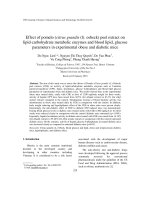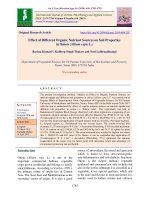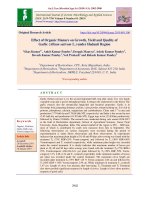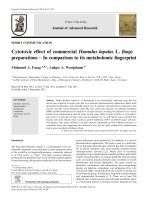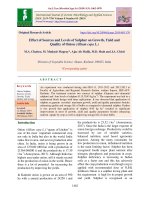Effect of sources and levels of sulphur on growth, yield and quality of onion (Allium cepa L.)
Bạn đang xem bản rút gọn của tài liệu. Xem và tải ngay bản đầy đủ của tài liệu tại đây (257.05 KB, 9 trang )
Int.J.Curr.Microbiol.App.Sci (2019) 8(3): 1462-1470
International Journal of Current Microbiology and Applied Sciences
ISSN: 2319-7706 Volume 8 Number 03 (2019)
Journal homepage:
Original Research Article
/>
Effect of Sources and Levels of Sulphur on Growth, Yield and
Quality of Onion (Allium cepa L.)
M.A. Chattoo, M. Mudasir Magray*, Ajaz Ah Malik, M.D. Shah and J.A. Chisti
Division of Vegetable Science, Skuast, Kashmir-190025, India
*Corresponding author
ABSTRACT
Keywords
Onion, Sulphur,
Sources, Levels,
Growth, Yield,
Quality and storage
Article Info
Accepted:
12 January 2019
Available Online:
10 February 2019
An experiment was conducted during rabi-2010-11, 2011-2012 and 2012-2013 at
Faculty of Agriculture and Regional Research Station, wadura Sopore, SKUASTKashmir. The treatment consists two sources of sulphur (Gypsum and elemental
sulphur) and four levels of sulphur (0,15,30,45 kg ha-1). The experiment was laid in a
randomised block design with three replications. It was observed that application of
sulphur as gypsum recorded maximum growth, yield and quality parameters besides
enhancing quality and storage life of bulbs as compared to elemental sulphur. Further
it was proved that application of sulphur @45 kg ha-1 resulted in significant
improvement in most of growth, yield and quality parameters besides enhancing
nutrient uptake by crop as well as improving storage life of onion bulbs.
Introduction
Onion (Allium cepa L.) “queen of kitchen” is
one of the most important commercial crop
not only in India but also in the world. India
ranks first in area, and next in production after
china. In India, onion is being grown in an
area of 1270.00 (000 ha) with a production of
21564.00(000 t) and the productivity is 17.30
t ha-1 (Annoymous, 2017). Although India has
highest area under onion, still it stands second
in the production of onion in the world. Hence
there is a lot of potential for increasing the
production by improving the yields.
In Kashmir onion is grown on an area of 950
ha with a annual production of 24250 t and
the productivity is 25.52 t ha-1 (Annoymous,
2017). Since the India is the larger exporter of
onion foreign exchange. Productivity could be
increased by use of suitable varieties,
balanced nutrition, need based agronomic
practices. Among the many constraints for
low production in onion, imbalanced nutrition
is the main limiting factor. Sulphur has been
recognised fourth major plant nutrient after
nitrogen, phosphorus and potassium in crops.
Sulphur deficiency is increasing in Indian
soils at a faster rate and this has adversely
affect the crop production even though crop is
applied with recommended dose of N,P,K
fertilisers Onion is a sulphur loving plant and
the requirement is high for its proper growth
and yield. Sulphur is recognised as an
1462
Int.J.Curr.Microbiol.App.Sci (2019) 8(3): 1462-1470
important nutrient for higher yield and better
quality of onion bulbs (Thippeswamy, 1993,
Tripathy et al., 2013). Severe sulphur
deficiency during bulb development has
detrimental effect on an alkaloid allylpropyl
disulphide, in which sulphur is the prime
constituent. Sulphur application not only
improves the bulb yield, pungency, flavours.
Other quality parameters but also improves
shelf life also, besides imparting resistance
against pests and diseases, Jaggi and
Dixit,1999 and Magray et al., 2017. Sulphur
is essential for building up of sulphur
containing amino acids, which are building
blocks for essential proteins in plants. It is
essential for vegetative growth and bulb
development in onion (Anwar et al., 2001).
Sulphur deficiency in Indian soils becomes
more prevalent due to extensive use of
sulphur free fertilisers. No sulphur application
in sulphur deficient soils has often resulted in
low yield of onion. Keeping in view the
significance of sulphur in the production of
onion crop, the present investigation “Effect
of Different Sources and Levels of sulphur on
growth, yield and quality of onion cv. yellow
onion was undertaken.
transplanting, while elemental sulphur was
applied before 15-20 days of transplanting.
The recommended dose of phosphorus (50 kg
ha-1), potash (80 kg ha-1), half dose of
nitrogen (75 kg ha-1) were applied as top dose
on the onset of March. Farmyard manure of
seven weeks old were tranplanted @20 t ha-1
at a spacing of 15×10 cms in plots of 6.0×
2.00 m size in the last week of November
during 2010-13.Recommended package of
practices was adopted to raise a healthy crop.
The crop was harvested in last week of June
in all the three years. The Observations on
growth, yield, quality, storage life, nutrient
uptake and availability were recorded, using
standard procedures. The recorded data was
subjected to stastiscal analysis as per the
procedure suggested by Panse and Sukhatame
(1978).
Results and Discussion
Effect on growth and yield attributing
parameters are presented in table 1
Effect of sources of sulphur
Growth and yield parameters (Table 2)
Materials and Methods
A field experiment was conducted during
rabi-2010-11,2011-2012 and 2012-2013 at
Faculty of Agriculture and Regional Research
Station, wadura Sopore, SKUAST-Kashmir.
Soil of the experimental plot was clay cloam,
having PH of 7.21, Soil organic Carbon
0.60%, Electrical conductivity 0.160 dsm-1,
available N, P, K and S, 315,
18.09:156.30:19.49 kg ha-1 respectively. The
treatment consists two sources of sulphur
(Gypsum and elemental sulphur) and four
levels of sulphur (0, 15, 30, 45 kg ha-1). The
experiment was laid in a randomised block
design with three replications. The gypsum as
a source of sulphur as per treatments as per
treatments was applied at the time of
The results on vegetative parameters as
influenced by sources indicate a varied
response. Number of leaves and plant height
showed significant variations, gypsum
recording maximum values of 72.57 cm and
12.11 for plant height and number of leaves
plant-1 respectively as compared to elemental
sulphur (69.25 cm, l0.72 leaves plant-1). Neck
thickness and collar thickness exhibited a
non-significant response to sulphur sources
recording lower values of 10.22 and 1.80cm
respectively with gypsum.
As per table 2 Yield and yield related
attributes were significantly influenced by
sulphur sources, gypsum proved superior to
elemental sulphur. Gypsum recorded higher
1463
Int.J.Curr.Microbiol.App.Sci (2019) 8(3): 1462-1470
values of 6.52 cm,6.13cm and 86.26 gram,
436.41 q ha-1 and 405.73 q ha-1 for equatorial
diameter, polar diameter, average bulb
weight, total bulb yield and marketable yield
respectively and were significantly superior to
the values recorded with elemental sulphur.
Gypsum as a source of sulphur gave an
additional bulb yield of 17.54 q ha-1 over
elemental sulphur.
Quality parameters
Keeping quality, TSS and Pyruvicid acid
content of onion bulbs was significantly
influenced by sulphur sources, gypsum
recorded a storage loss of 30.96 which was
3.19 % less, than that recorded with elemental
sulphur (34.15) (Table 3).
Gypsum recorded significantly higher values
of 11.01% and 6.75 µmolg-1 for TSS and
pyruvic acid respectively as compared to
elemental sulphur (10.51% and 6.54 µmolg-1).
Nutrient uptake
Nutrient uptake depicted a significant
response to sulphur applications. Gypsum
recorded a uptake of 85.25, 20.51, 70.82 and
27.93 kg ha-1 for nitrogen, phosphorus,
potassium and sulphur respectively and were
found significantly superior to the values
recorded with elemental sulphur.
Nutrient build up after harvest, resulted an
improvement, nitrogen and potassium
depicted a non significant build up, while in
phosphorus and sulphur, the build up was
significant.
Gypsum proved superior to elemental
sulphur, recording a nutrient build up of
380.74, 29.20, 205.22 and 27.38 kg ha-1 for
nitrogen, phosphorus, potassium and sulphur
respectively (Table 2).
Effect of levels of sulphur
Growth and yield parameters
The data on growth, yield and yield attributes
depicted influenced by different levels of
sulphur indicate significant variations among
different levels of sulphur. A marked increase
in the values was observed with the increasing
levels.
Application of sulphur@45 kg ha-1(L4)
recorded significantly highest values of 76.40
cm for plant height as compared to all levels.
L4 (45 S kg ha-1) recorded a leaf number of
12.88 cm, which was significantly superior to
L1 (10.09) and L2 (10.82) but was statistically
at par with T3 (11.86). Neck Thickness and
collar thickness recorded lower values of 0.18
cm and 1.54 cm, which were significantly
lower to the values recorded with other levels,
but exhibited at par results with T3(30 kg S
ha-1) with respect to collar thickness (1.74
cm). Significant variations among sulphur
levels were observed with respect to yield and
yield related attributes of onion (Table 2).
Sulphur level L4 (45 kg ha-1) significantly
registered higher values of 6.84cm,6.55 cm,
93.43g, 452.51 q ha-1 and 483.03 q ha-1 for
equatorial diameter, polar diameter, average
bulb weight, total bulb yield and marketable
yield respectively as compared to other levels.
Sulphur level 45 kg ha-1 (L4) registered an
increase in yield by 29.32%, 16.25% and
10.14% over L1 (0 kg Sha-1), L2 (15 kg ha-1)
and L3 (30 kg ha-1) respectively. Similar
findings have also been reported by Kumar
and Singh (1994), Channagourda et al.,
(2009) in onion and Magray et al., (2017) in
garlic.
Quality parameters (Table 3)
Significantly highest values of 11.54 %,7.06
µ mol g-1 were recorded with the application
1464
Int.J.Curr.Microbiol.App.Sci (2019) 8(3): 1462-1470
of 45 kg S ha-1 for TSS and pyruvic acid
content.L4 (45 kg S ha-1) recorded a storage
loss of 26.18% which was 13.78 % less than
that recorded with control (39.96%) (Table 3).
Nutrient uptake
Significant variations were observed for
nutrient uptake among sulphur levels. Sulphur
application L4 (45 kg ha-1) recorded an
uptake of 94.44,23.89,78.65 and 32.54 kg ha-1
for nitrogen, phosphorus, potassium and
sulphur were found significantly superior the
values recorded with rest of the levels.
Nutrient build up after harvest resulted an
improvement in nitrogen availability depicted
a non-significant build up, while phosphorus,
potassium and sulphur resulted in a
significant build up. L4 (45 kg ha-1) recorded
higher nutrient build up of 386.23, 30.43,
189.34 and 30.04 kg ha-1 for nitrogen,
phosphorus,
potassium
and
sulphur
respectively (Table 4).
All the interaction effects on growth, yield
and quality parameters were found nonsignificant except PWL %.
Table.1 Initial status of experimental field with respect to available N, P, K, S, OC and soil pH
Character
Value
Method
Organic carbon (%)
0.60
Walkley and Blacks Method (1934) (Jackson,
1973)
Soil pH
7.21
1:2.5 soil water suspension with Beckman’s Glass
Electrode pH Meter (Jackson,1967)
Available N (kg ha-1)
315
Subbiah and Asija (1956)
(Alkaline potassium permanganate method)
Available P (kg ha-1)
18.09
Olsens Method (1954)
(Extraction with 0.5 M NaHCO3)
Available K (kg ha-1)
156.30
Extraction with Neutral Normal Ammonium
Acetate (Jackson, 1967)
Available S (kg ha-1)
19.49
Extraction by (Williamns and Steinberg, 1959)
method and determination by turbidimetric
(Chesnin and Yien, 1951) method
1465
Int.J.Curr.Microbiol.App.Sci (2019) 8(3): 1462-1470
Table.2 Effect of various levels of sulphur on growth and yield contributing characteristics of onion (Allium cepa L.)
Treatment
Sources
S1
S2
C.D
Levels
L1 =0 kg ha-1
L2 =15kg ha-1
L3 =30 kg ha-1
L4 =45 kg ha-1
C.D
SxL
S1L1
S1L2
S1L3
S1L4
S2L1
S2L2
S2L3
S2L4
C.D @5%
CV
Plant
height
(cms)
No. of
leaves
Equator
Dia
(cms)
Polar
Dia
(cms)
Neck
thickness
(cms)
Collar
Thickness
(cm)
Average bulb
weight (g)
Marketable
Yield
q ha-1
Total Bulb
Yield
qha-1
72.57
69.33
1.75
12.11
10.72
0.76
6.52
6.23
0.16
6.13
5.80
0.16
0.22
0.23
NS
1.80
1.86
NS
86.26
80.98
2.06
405.73
372.09
9.51
436.41
418.87
11.23
63.94
69.86
73.45
76.40
2.47
10.09
10.82
11.86
12.88
1.07
5.83
6.31
6.54
6.84
0.23
5.36
5.82
6.12
6.55
0.23
0.28
0.23
0.22
0.18
0.03
2.15
1.89
1.74
1.54
0.23
74.49
80.89
85.68
93.43
2.92
330.40
370.58
402.14
452.51
13.45
373.50
415.48
438.56
483.03
15.88
64.53
70.41
76.00
79.36
63.36
69.31
70.90
73.44
NS
2.82
10.41
11.13
12.94
13.94
9.77
10.50
10.78
11.81
NS
7.59
5.99
6.50
6.62
6.98
5.67
6.13
6.45
6.69
NS
2.90
5.50
6.12
6.20
6.70
5.23
5.52
6.05
6.39
NS
3.14
0.27
0.23
0.20
0.17
0.28
0.24
0.23
0.19
NS
11.04
2.12
0.23
0.20
0.17
0.28
0.24
0.23
0.19
NS
10.11
75.97
83.84
88.49
96.73
73.00
77.93
82.88
90.13
NS
2.82
339.48
388.11
419.70
475.61
321.32
353.05
384.58
429.41
NS
2.79
377.11
423.74
447.60
497.18
369.89
407.21
429.52
468.87
NS
3.00
1466
Int.J.Curr.Microbiol.App.Sci (2019) 8(3): 1462-1470
Table.3 Effect of various levels of sulphur on storage loss and bulb quality of onion
Treatments
Sources
S1
S2
C.D
Levels
L1 =0 kg ha-1
L2 =15kg ha-1
L3 =30 kg ha-1
L4 =45 kg ha-1
C.D
SXL
S1L1
S1L2
S1L3
S1L4
S2L1
S2L2
S2L3
S2L4
C.D (5%)
C.V
PLW (%)
Sprouting (%)
Rotting (%)
Total
Losses
(%)
T.SS
(%)
Pyruvic acid
(µ mol g-1)
17.79
19.67
0.90
9.73
10.70
0.99
3.44
3.78
0.28
11.01
10.51
0.36
6.78
6.54
0.22
22.54
19.58
17.30
15.50
0.90
12.88
10.97
9.21
7.81
0.99
4.54
3.76
2.87
78.65
0.40
30.96
34.15
39.96
31.83
24.61
29.21
32.54
0.94
10.06
10.56
10.88
11.54
0.52
6.34
6.59
6.65
7.06
0.32
22.50
17.83
16.04
14.77
22.57
21.32
18.56
16.23
1.27
3.88
12.40
10.57
8.71
7.23
13.36
11.37
9.70
838
NS\
7.80
4.56
3.43
3.16
2.61
4.52
4.08
3.39
3.12
NS
8.94
39.46
31.83
27.91
24.61
40.45
36.77
31.65
27.55
-----
10.15
10.83
11.17
11.90
9.98
10.29
10.58
11.18
NS
3.87
6.35
6.68
6.75
7.35
6.33
6.51
6.56
6.77
NS
3.82
1467
Int.J.Curr.Microbiol.App.Sci (2019) 8(3): 1462-1470
Table.4 Effect of various levels of sulphur on nutrient uptake of onion (Allium Cepa L.)
Treatment
Sources
S1
S2
C.D
Levels
L1 =0 kg ha-1
L2 =15kg ha-1
L3 =30 kg ha-1
L4 =45 kg ha-1
C.D
SXL
S1L1
S1L2
S1L3
S1L4
S2L1
S2L2
S2L3
S2L4
C.D (5%)
C.V
Nitrogen Uptake
(Kg ha-1)
Phosphorus Uptake
(Kg ha-1)
Potassium Uptake
(Kg ha-1)
Sulphur Uptake
(kg ha-1)
85.25
81.71
2.68
20.51
18.74
0.57
70.82
68.18
1.78
27.93
25.63
0.66
71.85
81.25
86.39
94.44
3.78
14.88
18.15
21.57
23.89
0.81
60.75
67.24
71.37
78.65
2.52
20.77
24.61
29.21
32.54
0.94
73.71
82.43
87.97
96.91
69.99
80.08
84.81
91.96
NS
3.66
15.25
19.25
22.45
25.08
14.51
17.05
20.69
22.71
NS
3.34
61.03
68.87
72.76
80.61
60.46
65.60
69.97
76.70
NS
2.93
21.39
25.42
30.76
34.17
20.15
23.81
27.65
30.92
NS
2.83
1468
Int.J.Curr.Microbiol.App.Sci (2019) 8(3): 1462-1470
The increase in growth, yield and yield
related attributes could be due to its role in
balanced nutrition and performs in any
physiological functions like synthesis of
sulphur containing aminoacids, development
of profused root system, resulting in increased
nutrient uptake, ultimately increasing the
photosynthesis, leading to improved growth,
higher yield. Similar findings have also been
reported by better quality, higher nutrient
uptake and sustainable nutrient bulb up in the
soil (Dudhat et al., 2011, Yaduvanshi and
Yadav 2007, Jaggi, 2004, Tripathy et al.,
2013, Magray et al., 2017, Nasrin et al., 2007.
In conclusion, the results can be summarised
as, the application of sulphur @45 kg ha-1
through gypsum is useful to promote better
growth, yield, quality, storage life of onion
and sustainable nutrient build up in the soil.
References
Ahmed M.K, DK Aditya, Siddigue M.A
1999. Effects of nitrogen and sulphur
application on the growth and yield of
onion cv. Faridpur Bhatti, Bangledesh
Hort, 1988; 46(1): 36-41.
Alam M.D, Effect of Paclobutrozol and S
fertiliser on the growth, yield and sulphur
content of garlic. MSc. Thesis,
Bangladesh Agri, Univ, Mymensingh,
1995: 92-95.
Alam M.D, Rahim, M.A, Sultana, MS. Effect
of paclobutrazol and sulphur fertiliser on
the growth and yield of garlic.
Bangladesh Journal Of Training and
Development, 1999; 12(1-2):223-230.
Annonymous, 2016-17. National Horticulture
Board, Area and Production of
Vegetables for the year 2013-14.
Anwar, M.N., Sarker, J.U., Rahman, M.,
Islam, M.A., Begum, M., 2001. Response
of onion to nitrogen, phosphorus,
potassium, sulphur and zinc. Bangladesh
Journal of Environment Science 7, 68−72
August KT. Hyposholesterolacmic effect of
garlic (Allium Sativum L.). Indian J Expt.
Biol, 1977: 15(6):489-490.
Aulakh MS. Crop response to sulphur
nutrition in Y.P. Abrol and A. Ahmad
(eds). Sulphur in plant. Kluwer Academic
Publ. Dordrecht, 2003; 341-354. Aus J.
Food Ag-Ind. Special Issue, 2009; 18-23.
Bose TK, MG Som, Vegetable Crops in India
1990: 583-601.
Channagouda, R.F., Ajjappalavara, P.,
Kamble, A.S., 2009. Response of onion
to different levels of irrigation and
sulphur in alfisoils of Northern
transitional tract of Karnataka. The Asian
Journal of Horticulture 4(1), 152−155
Chesnin, L. and Yien, C.H. 1951.
Turbidimetric determination of available
sulphate. Soil Science Society of America
Proceedings 15: 149-151.
Dudhat M S, Chovatia P K, Sheta B T and
Thesiya N M 2011 Effect of sources and
levels of sulphur fertilizers on bulb yield
of onion (Allium cepa L.). Intl. J. Pl. Sci.
6: 134–136.
Farooqui MA, Naruka IS, Rathore SS, Singh
PP, Shaktawat RPS et al., Effect of
nitrogen and sulphur levels on growth
and yield of garlic (Allium sativum L.).
FAOSTAT 2011 Food and Agriculture
Hore JK. Ghanti S, Chanchan M. Influence of
nitrogen and sulphur nutrition on growth
and yield of garlic (Allium sativum L.).
Journal of Crop and Weed. 2014; 10(2):
14-18
Hossain MM. Effect of different levels of
nitrogen and potash on the growth and
yield of garlic.MS Thesis. Dept. Hort
Bangladesh Agril. Univ, Mymensingh,
1997; 65.
Jackson, M.L. 1967. Soil chemical analysis.
Prentice Hall of India Pvt. Ltd., New
Delhi, pp. 162-165.
Jackson, M.L. 1973. Soil chemical analysis.
Prentice Hall of India Pvt. Ltd., New
Delhi.
1469
Int.J.Curr.Microbiol.App.Sci (2019) 8(3): 1462-1470
Jaggi R.C. Effect of sulphur levels and
sources on composition and yield of
onion (Allium cepa). Ind J of Agri. Sci.,
2004; 74(4); 219-220.
Jaggi RC, Dixit SP, Onion (Allium cepa L.)
response of sulphur in representative
vegetable growing soils of Kangra Valley
of Himachal Pradesh. Ind. J. Agri. Sci.,
1999; 69(4):289-291.
Kumar, A., Singh, O., 1994. Role of sulphur
in nutrient utilization and catalase activity
in onion crop. Indian Journal Agricultural
Research, 28, 15−19.
Magray M. Mudasir, Chattoo. M.A, Narayan.
S, Najar, G.R, Jabeen Nayeema and
Ahmad Tariq. Effect of sulphur and
potassium applications on growth and
chemical characteristics of garlic 2017.
The Bioscan, 12(1):471-475.
Nagaich KN, Trivedi SK, Lekhi R. Effect of
sulphur and potassium fertilisation in
onionj (Allium cepa L). Hort. J., 1999;
12:25-31.
Nasreen S, Haque M, Hossain M, Farid A
(2007) Nutrient uptake and yield of onion
as influenced by nitrogen and sulphur
fertilization. Bangladesh J Agric Res 32:
413-420.
Olsen, S.R., Coleman, C.W., Watnabe, F.S.
and Dean, L.A. 1954. Estimation of
available phosphorus with sodium
bicarbonate. United States Department of
Agriculture Circular 939: 19.
Panse VG, Sukhatme PU, Statistical Methods
for Agricultural workers, ICAR, New
Delhi, 1978.
Pitam D. Medina Research Station and John
Burt, Horticulture Adviser, South Perth,
2008.
Randle. WM. Onion germplasm interacts with
sulphur fertility for plant utilisation and
bulb pungency. Euphytica.1992; 59(23):151-6.
Subbiah, S.S. and Asija, C.L. 1956. A rapid
procedure for the estimation of available
nitrogen in soil. Current Science, 25:
259-260.
Tandon, H.L.S. 1993. Methods of analysis of
soils, plants, waters and fertilizers.
Fertilizer development and consultant
organization, New Delhi.
Thippeswamy, H.J., 1993. Leaf sampling
guide and nutrient norms in yield and
quality in relation to applied sulphur to
onion. M.Sc. (Agri.) Thesis, University
of Agricultural Science, Bangalore
Tripathy, P., Sahoo, B.B., Priyadarshini, A.,
Das, S.K. and Dash, D.K. 2013. Effect of
sources and levels of sulphur on growth,
yield and bulb quality in onion (Allium
cepa L.). International Journal of Bioresources and Stress Management
4(4):641-644.
Walkley, A. and Black, J.A. 1934. An
estimation of the method for determining
soil organic carbon and a proposed
modification of the chemical and titration
method. Soil Science, 37: 29-39.
Williams, C.H. and Steinberg, A. 1959. Soil
sulphur fractions and chemical indices of
available sulphur in some Australian
soils. Australian Journal of Agricultural
Research 10: 340-352.
Yaduvanshi N P S and Yadav D V 2007 Soil
sulphur status and sugarcane response to
different levels, methods and source of
sulphur application. Curr. Agri. 31: 55–
59.
How to cite this article:
Chattoo, M.A., M. Mudasir Magray, Ajaz Ah Malik, M.D. Shah and Chisti, J.A. 2019. Effect
of Sources and Levels of Sulphur on Growth, Yield and Quality of Onion (Allium cepa L.).
Int.J.Curr.Microbiol.App.Sci. 8(03): 1462-1470. doi: />
1470
